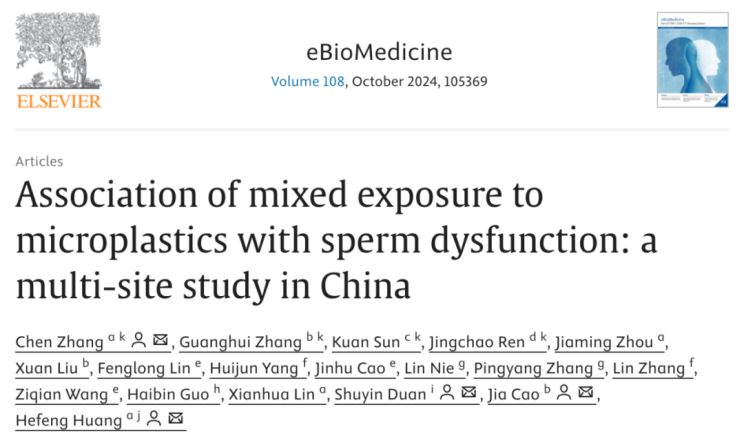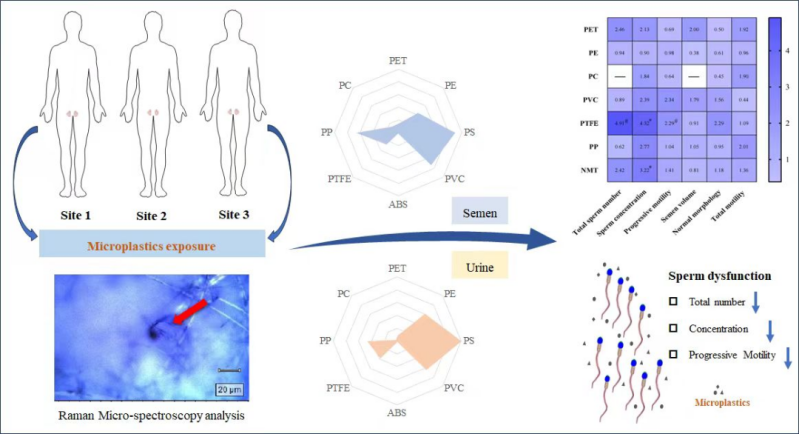Microplastics, which refer to plastic fibres, particles or films less than 5 mm in length, have now become a new type of pollutant spreading across the global ecosystem. In our daily life, people inevitably ingest microplastics through diet, inhalation or skin contact, etc. It is estimated that on average, we ingest 0.1 to 5 grams of microplastics per week, which is likely to pose a hidden danger to human health.
New types of pollutants that are globally dispersed
Indeed, many studies have detected the presence of microplastics in tissues such as human faeces, lungs, blood and placenta, as well as in breast milk, suggesting that the human body has been extensively contaminated by microplastics. Not coincidentally, sperm counts in men have been decreasing in recent decades, with the cause of 40 per cent of these low sperm counts remaining unexplained, while many studies have suggested that it is related to chemical pollution. However, there is a lack of research related to the distribution and accumulation of microplastics in the male reproductive system and their impact on reproductive health.
Latest Research Progress
Recently, a research team published a paper in eBioMedicine, a sub-journal of The Lancet, entitled: Association of mixed exposure to microplastics with sperm dysfunction: a multi-site study in China.

Reference:https://doi.org/10.1016/j.ebiom.2024.105369
The researchers examined eight types of microplastics in semen and urine samples from 113 men in three different regions of China, and the results showed that microplastics were detected in all samples, with the majority exposed to 3-5 different types of microplastics, all with similar exposure types.
Notably, exposure to polytetrafluoroethylene (PTFE), a commonly used coating for non-stick cookware, as well as the number of microplastic exposure types, was strongly associated with a significant decrease in sperm quality, affecting total sperm count, sperm concentration, and sperm viability, and the study suggests that microplastic contamination may be hazardous to male reproductive health.
Research Content
In this study, the research team conducted a cross-sectional study involving 113 male participants from three regions of China. Sperm and urine samples were collected and analysed using Raman microscopy to detect eight microplastics in the samples: polystyrene (PS), polypropylene (PP), polycarbonate (PC), polyethylene (PE), polyvinyl chloride (PVC), polytetrafluoroethylene (PTFE), polyethylene terephthalate (PET), and acrylonitrile-butadiene-styrene (ABS), and to assess sperm quality parameters (including total sperm count, concentration, viability and morphology). Statistical analyses such as univariate and multivariate modelling were used to assess the association between microplastic exposure and sperm quality, with a focus on the effect of polytetrafluoroethylene (PTFE), after adjusting for confounders such as age, body mass index (BMI), smoking, alcohol consumption and sampling location.

The research team detected the presence of microplastics in all semen and urine samples from participants who were typically exposed to 3-5 different microplastics, with polystyrene (PS), polypropylene (PP), and polyethylene (PE) having the highest detection rates. Of interest, polytetrafluoroethylene (PTFE) was significantly associated with decreased semen quality.
Note: Polytetrafluoroethylene (PTFE) is a high polymer polymerised with tetrafluoroethylene as the monomer, which has excellent heat and cold resistance, acid and alkali resistance, resistance to a variety of organic solvents, and a very low coefficient of friction, and has been widely used as a coating material, for example, for the coating of non-stick pans.
Total sperm count, sperm concentration, and forward motility were significantly lower in the PTFE-exposed group compared with participants not exposed to PTFE. Analysis of the data showed that each additional microplastic exposure type was associated with a significant decrease in total sperm count, sperm concentration, and forward motility.
Be wary of microplastics around you
Overall, this study highlights the human health hazards of microplastic contamination, particularly the potential reproductive health risks posed by polytetrafluoroethylene (PTFE, a commonly used coating material for non-stick cookware), and suggests the feasibility of urine testing as an indicator of male reproductive microplastic exposure. Future studies need to further elucidate the potential mechanisms of microplastic effects on male fertility and across generations.






Post comments